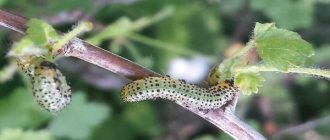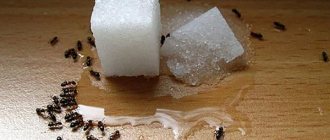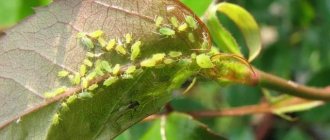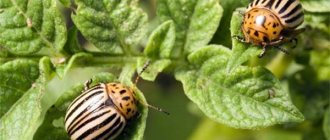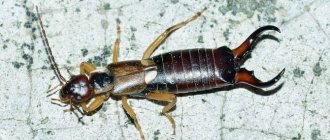Butterflies and their larvae (caterpillars) are attracted to the juice of cruciferous plants, in particular cabbage. Cabbage plants lay eggs, from which voracious larvae emerge, capable of eating an entire head of cabbage in a few days. You can fight harmful animals using folk remedies aimed at destroying egg clutches and reducing the caterpillar population.
What caterpillars and butterflies parasitize cabbage?
Caterpillars and butterflies are most often found in cabbage beds. These pests feed on plant leaves, causing the cabbage to begin to wilt.
Whitefly
A whitefly is a butterfly with white wings edged with a black stripe. The lower wing is usually yellowish. You can also notice a black dot on the wings. The butterfly is not very large in size.
The whitefly lays eggs on the underside of cabbage leaves in May. The butterflies themselves do not cause any harm to the cabbage; only the hatched whitefly larvae cause damage. After hatching, the caterpillars crawl to the outside of the leaves and feed on them. The appearance of caterpillars in the beds leads to a delay in the development of cabbage seedlings. The whitefly reproduces very quickly, and three generations of insects can be replaced in one summer.
scoop
The cutworm is a small moth that is predominantly nocturnal. The pest is gray in color; cutworm larvae are green-brown. Moths lay eggs on plants. And after the larvae hatch, they feed on cabbage leaves, thereby causing damage to the entire crop. Cabbage cannot develop normally and begins to wither.
Green caterpillar
Another pest that is often found in cabbage beds is the green caterpillar. The eggs, from which green caterpillars then emerge, are laid by the cabbage moth. The pest appears in the beds at the end of April and lives on cabbage until July. Over time, the green caterpillar can cause serious damage to the crop if you do not start to fight it.
How to protect cabbage from pests
Cabbage attracts many pests who are not averse to eating its juicy leaves. As a result, the seedlings are literally eaten immediately after planting by cruciferous flea beetles, or in the fall the heads of cabbage are spoiled by caterpillars. Other pests cause no less damage.
Instructions
- After planting cabbage seedlings in the garden, they are attacked by cruciferous flea beetles. These are small jumping insects that chew small holes into cabbage leaves, turning them into a sieve. The seedlings dry out immediately. And if urgent measures are not taken, the young plants will be destroyed in 2-3 days. Therefore, immediately after planting the seedlings in the garden, pollinate them with stove ash or spray them with one of the preparations for garden pests. For example, take “Intavir”, “Karate”, “Commander”, etc.
- Cabbage aphids are no less dangerous. It needs to be combated with chemicals such as Carbofor, Antio, Rovikurt, etc., as well as folk methods. Use an infusion of garlic, potato or tomato tops, ash, tobacco, and green soap. The solution is prepared as follows. Pour 10 liters of cold water into 3-4 kg of tops or garlic arrows and let it brew. Then add 50 g of green soap; to do this, dissolve it in water. Treat the cabbage with a broom and then do not water from above, but only under the root.
- But the most difficult thing to fight is the caterpillars of the cabbage cutworm and the cabbage moth, which harm the cabbage when there are already heads of cabbage and it is not advisable to treat with chemicals, because there are 20-30 days left before the harvest. In this case, use folk remedies. First, hand-collect the pests you see. Then prepare an infusion of tomato tops, potato tops or wormwood. Take 3-4 kg of grass per bucket of water. Leave for a day, then sprinkle generously on the heads of cabbage.
- KakProsto.ru
Signs of cabbage damage
A characteristic sign that pests are appearing on the bushes is the presence of holes and gnawed leaves. It can also be noted that the seedlings begin to grow poorly and stop developing. If large heads of cabbage appear, you can see holes in them, and if you open such a head of cabbage, there may be larvae there.
If you examine the bushes, you will notice the appearance of eggs on the cabbage leaves. They are usually located on the inside of the leaf. You can also pay attention to the fact that if butterflies or moths often fly near the beds, then most likely, after some time, larvae will appear on the seedlings.
What harm is done to vegetable crops?
The butterflies themselves do not pose a threat to cabbage. Damage to the crop is caused by larvae, which the pests lay on the foliage. After the larvae hatch, they begin to eat the succulent young leaves. Because of this, the seedlings stop developing and may die completely.
If the larvae appear on formed heads of cabbage, they gnaw through them. Subsequently, the cabbage withers and disappears.
If there are a lot of larvae, they are able to gnaw out entire heads of cabbage. Naturally, after this the head of cabbage can be thrown away. Over the summer, if pests are not controlled, they can multiply so much that they destroy not only the cabbage crop, but also other agricultural crops.
Benefits of using chemical-free products
Unlike aggressive chemicals, which are often used to kill pests on the site, folk remedies are not toxic and are not absorbed into plant tissue.
Traditional methods are safe and can be used even when the harvest is almost ripe.
We save the cabbage harvest using folk methods in any growing season. The same cannot be said about the use of chemicals. They can be used only in the early stages of growth, when the heads of cabbage have not yet formed. Although chemicals are more effective, especially if the pest population is very large. Folk remedies help cope when there are not very many caterpillars and butterflies on cabbage.
Traditional methods of fighting caterpillars
What to do if insects appear on cabbage and destroy the crop, how to get rid of pests without harming the crop. There are many effective and yet safe methods for controlling insects in cabbage beds.
Sugar solution
Treating the crop with a sugar solution is used to attract wasps to the area. Caterpillars are afraid of wasps because they feed on larvae and eggs. To prepare a sugar solution, you need to take 2 liters of warm water and add 500 g of sugar to it. You can also use old jam. Stir thoroughly to form a sugar syrup and sprinkle over the cabbage heads. The sweet smell will attract wasps, and they, in turn, will destroy the larvae and eggs of cabbage pests.
See also
50 best varieties of broccoli with name and description
Read
Chicken eggs
A very original way to get rid of white butterfly on cabbage is to use chicken eggs, or rather, egg shells. Among the cabbage beds, wooden stakes are driven into the soil, and halves of egg shells are hung on them. You can only use white shells; brown eggs are not suitable for this method.
Butterflies mistake white shells for their relatives and do not lay eggs, believing that the place is already occupied.
Tomato tops
The white butterfly searches for its favorite vegetable by smell, so if you kill the smell of cabbage, you can prevent the appearance of caterpillars in the beds. A decoction of tomato tops is suitable for this. Butterflies cannot tolerate the smell of tomatoes and will not lay eggs if they smell it.
Tomato tops are poured with 3 liters of water and put on fire. Bring the broth to a boil and remove from heat. Let the broth cool. To make the decoction stick better to the leaves after processing, grated shavings of laundry soap are added to it. Spraying is best done after sunset. It is also worth checking the weather forecast to ensure there is no rain in the coming days.
Soda solution
Another effective remedy for butterflies and caterpillars on cabbage is spraying with a soda solution. Half a pack of soda is diluted in 5 liters of water and poured into a spray bottle. Spray the heads of cabbage with the solution after sunset and watering. Instead of a solution, you can sprinkle soda on the foliage and leave it like that for several days. The main thing is that it doesn’t rain in the coming days and wash away the soda.
Ash infusion
Ash infusion is very effective against caterpillars. Wood ash is diluted in water and allowed to brew for 24 hours. The more ash you add, the more effective the product will be. Add 5 tbsp to the finished infusion. l. tar soap. Then the cabbage beds are sprayed with the resulting infusion.
Black pepper decoction
A decoction of black pepper will help get rid of caterpillars on cabbage. A package of black peppercorns is filled with 2 liters of water and put on fire. Boil the broth for 15 minutes. Then let it brew under a closed lid for 2-3 days. Before watering, the broth is diluted in water and shavings of laundry soap are added. Water the beds with the resulting decoction every 2 days.
Mustard and vinegar
You can pickle cabbage using mustard powder and vinegar. 50 g of mustard are diluted in water, then infused for 3 days in a dark room. Before spraying, the infusion is filtered through cheesecloth. Water the resulting mustard infusion over the beds along with the foliage. This product helps to cope not only with caterpillars, but also with slugs. Spraying the bushes with vinegar diluted in water is also effective. 4 tbsp. l. vinegar is diluted in 4 liters of water and the plants are treated.
Valerian infusion
White butterflies cannot tolerate the smell of valerian, so they do not lay eggs where this plant grows.
How to prepare a decoction of valerian to repel whites:
- Cut off the leaves and stems of the plant, finely chop the roots.
- Fill with water and put on fire.
- Boil for 10 minutes.
- When the broth is ready, cover it with a lid and let it brew for 24 hours.
- Water the beds with infusion from a regular watering can.
You need to water cabbage with valerian several times a week after sunset. Valerian can also be planted in a plot next to some crops. This plant has a very strong smell that repels insects from the area.
Hot pepper decoction
A decoction of hot pepper can be quite effective against caterpillars on cabbage. Several pieces of hot pepper are crushed, poured with water and put on fire. Bring to a boil. After this, cool the broth and, before spraying the beds, strain it through cheesecloth.
Burdock infusion
A decoction of burdock leaves will help get rid of caterpillars on cabbage. The leaves contain substances that act as poison on caterpillars. To prepare the infusion, fresh burdock leaves are cut and crushed. Then fill with water. Infuse burdock infusion for two days. Before spraying the cabbage, filter it and add water.
Infusion of burdock and garlic
An infusion of burdock and garlic will help destroy caterpillars on cabbage. Chop burdock and garlic leaves and add 3 liters of water. Insist for 2 days. Before watering, dilute with warm water.
Another way to prepare an infusion is to add tar soap to it. Grind the green parts of the plants and fill them with water. Leave to ferment for 2 days. Before spraying the plants, add 70 ml of tar soap. To stir thoroughly. Treat cabbage every three days until the caterpillars disappear from the area.
See also
Growing and caring for broccoli in open ground and greenhouse
Read
Tobacco dust
40 g of tobacco dust is poured into 3 liters of water. They insist for three days. Before processing, cabbage is diluted with water and laundry or tar soap is added. Another way is to grow smoking tobacco in your garden, cut off the leaves as they grow, and dry them. Grind, and in the spring after transplanting the seedlings into open ground, sprinkle with tobacco. The unpleasant smell of tobacco will scare off butterflies, and they will not lay eggs on seedlings.
Soap-ash infusion
To prepare a soap-ash solution you will need 500 g of ash, 100 g of grated laundry soap and 4 liters of water. Dilute all ingredients in water and let it brew for 24 hours. Spray cabbage every 3 days in the evenings.
Tansy flower powder
Tansy inflorescences are cut off and laid out in a dark room to dry. When the flowers are dry, they are ground into flour. The resulting tansy powder is used to dust the beds. Tansy has a specific smell that repels insects. Foliage can also be used along with the inflorescences.
Prevention
There are two species of butterflies whose caterpillars cause damage to crops: the cabbage cutworm and the white moth. The white butterfly or cabbage butterfly is a medium-sized butterfly with white wings, on top of which there are dark spots. One individual can lay up to three clutches of eggs per season. Most often you can find them on the underside of a cabbage leaf.
Another dangerous crop pest is the cabbage cutworm. It is distinguished by its brown color. The eggs are round in shape and white in color. The butterfly lays them inside the head of cabbage. One individual can make one or two clutches per season. Cabbage is eaten by cabbage cutworm caterpillars. They gnaw passages in the cabbage, which leads to rotting of the cabbage.
It is quite possible to avoid the appearance of caterpillars on the site. To do this you need:
- Cover the beds with netting, thin tulle or spunbond, which will prevent butterflies that lay larvae in the leaves from getting to the cabbage.
- When a weed appears, remove it immediately, as weeds attract butterflies.
- Place useful plants next to the cabbage bed.
- Regularly inspect the underside of cabbage leaves, removing clutches of eggs in time.
- Conduct preventive spraying with insecticides in a timely manner.
- Strengthen plant immunity with healthy fertilizers.
- Attract natural enemies of caterpillars to the site (birds, insects).
- Mulch the ground with fragrant herbs and pine needles - butterflies will not even come close to such an area.
- In the fall, after harvesting, completely clear the area of plant debris and dig the soil deeply - this will get rid of pests hiding in the ground.
Advice!
Combine feeding and extermination of parasitic animals. Boric acid, chicken droppings and herbal infusions will enrich the soil and repel insects.
To reduce the risk of caterpillars appearing in cabbage, you should, if possible, plant it between celery, onions or tomatoes. These plants have a strong odor that repels and irritates not only caterpillars, but also other ground pests, as well as midges and insects. You also need:
- remove rotten leaves in a timely manner;
- Weed the beds frequently. Thanks to this, tunnels and nests of caterpillars are destroyed;
- cover the cabbage with a special net that will protect it from pests;
- tear off the lower leaves from the heads of cabbage, since it is on them that the caterpillars are initially attached;
- after harvesting, remove all plant remains, remove them and burn them at the other end of the site, and carefully dig up the soil;
- promptly remove debris, branches, leaves from the site;
- regularly remove weeds;
- Carefully loosen the soil in extreme heat, as cracks in the ground become a good refuge for pests.
It is necessary to treat the garden bed against pests at all stages. To do this, seedlings are planted as early as possible. Every week, the leaves are carefully inspected in the evening and all insects found are destroyed.
To prevent the spread of the pest, the beds are kept clean. Weeds are a food source for butterflies.
The soil in the garden bed is regularly loosened. The depth of loosening is at least 10 cm. This helps to destroy clutches of eggs and the creatures themselves.
The appearance of harmful insects is prevented by the use of fertilizers. Colored crops are fed with superphosphate or potassium chloride.
Fighting scoop and cabbage
Another pests that often have to be dealt with are cutworms and cabbageweeds. You can also get rid of these pests using folk remedies.
Pepper
Pour water over ground black pepper and boil for 10 minutes. Strain and let cool to room temperature. Spray the cabbage with the broth after sunset. You can also use peppercorns. You can add onion skins to the black pepper decoction and boil with it.
Sagebrush
Pour water over wormwood leaves and leave for 24 hours. Spray the bushes 3 times a week. Another way is to scatter cut wormwood bushes over the area with cabbage. As soon as the branches begin to dry out, they are replaced with fresh ones. Wormwood can be scattered around the site until harvest. Wormwood has an unpleasant odor for butterflies, so they try to avoid it.
Litter
Watering with chicken droppings also repel armyworms. Dilute rotted chicken manure in warm water. Mix thoroughly and pour the resulting solution over the cabbage. Only rotted chicken manure should be used; fresh chicken manure is too concentrated and can burn all the cabbage roots.
Pheromone traps
Pheromone traps are a triangular container containing adhesive tape and pheromones that attract insects. Pests crawl inside and stick to the tape. This method is quite effective and safe for the crop. Pheromone traps can be purchased at gardening stores or made yourself.
To do this, you need to put together a triangular shape from the boards, before attaching adhesive fly tape to the bottom part. Set a trap in the cabbage beds.
Biological methods
Biological methods involve attracting birds and insects to the site that feed on pests. The only disadvantage of this method is that it is not the most effective and does not always help get rid of pests.
Wasps, ants and hornets
You can destroy butterflies and caterpillars on cabbage by attracting wasps, hornets and ants to the area. These insects feed on caterpillars. To do this, you can spray the bushes with sugar, honey or jam diluted in water. The sweet smell attracts insects to the cabbage, which in turn feed on the larvae that eat the leaves.
Birds and insects
Birds also love to feast on caterpillars. To attract birds, you can plant rowan on the site. Or scatter bread crumbs or seeds in the garden bed. You can also hang a feeder nearby. Many insects can be attracted to the site if you spray the beds with a sugar solution. You can resort to this method together with spraying cabbage with decoctions and infusions to destroy pests in the area.
Spices
Planting herbs among the cabbage beds will help save space on the site and at the same time prevent the appearance of insects. Most pests cannot tolerate the smell of herbs and inflorescences.
Herbs that repel pests:
- marigold;
- dill;
- garlic;
- tomatoes;
- borage;
- mint;
- sagebrush;
- tansy.
The only disadvantage of planting herbs is that it is the most ineffective way to protect against pests.
Cabbage pests and their control photo. Cruciferous flea beetle
Almost invisible, painted black and silver, moves very quickly and jumps deftly, loves seedlings and young leaves. Having noticed small holes on them, the first thing you should do is start fighting the cabbage flea beetle. If treatment is not started on time, this will lead to the death of plants and the spread of parasites.
There are several methods, they can be used together or separately. Before treating cabbage for pests, carefully study each method to choose the most accessible and suitable one.
- You can cover the beds with a non-woven covering fabric, thereby preventing insects from accessing them. After the seedlings have grown stronger and the leaves have become coarser, the covering can be removed, since the plant will no longer be edible for the flea beetle.
- The cabbage garden should be sprinkled with ash or its mixture with tobacco dust. This protection is very effective, but after rain, dew or fog this coating will have to be renewed.
- The flea is very sensitive to odors, so fir oil should be added to the irrigation water (up to 15 drops per bucket). It is also useful to plant garlic at the beginning of the season and, at the first shoots, place cabbage seedlings between them. A sharp and specific aroma will help repel insects.
- Treating cabbage against pests with vinegar is an effective and proven folk method. It consists of sprinkling the beds with table vinegar (7%), diluted in 10 liters of water. Experts advise checking the weather forecast before treating cabbage with vinegar against pests. If the weather is hot, dry, it is better to spray after sunset so that the leaves do not get burned. One procedure should be enough.
- A good remedy is to spray cabbage against parasites with an infusion of chicken manure (add 100-200 grams to a 10-liter bucket, leave for a day until completely dissolved). In addition to protection, it will become an excellent fertilizer, allowing seedlings to grow and become stronger faster.

